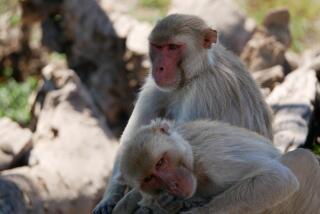Female Bats’ Devotion to Kin Starts With Mate
- Share via
Female horseshoe bats are family-minded creatures, coupling with the same male bat year after year, scientists have found. To keep their kinship links even tighter, mothers, daughters and grandmothers often pick the same male bat to mate with.
The findings, published Thursday in the journal Nature, emerged from a study of a population of greater horseshoe bats in the British countryside.
The colony, which has been monitored since the 1950s, consists of dozens of breeding females that live in the attic of a Victorian gothic mansion, raising their young together and sharing foraging sites and roosts with their kin.
Each fall, the females fly out to mate with solitary males that reside in caves in the surrounding countryside, then come back to the mansion.
Crawling into the caves and examining the bats, the researchers, of the universities of London and Bristol, noticed that related female bats were turning up at the same cave to mate. In the Nature study, they confirmed their suspicion by conducting DNA paternity tests, using biopsies from the wings of 452 bats collected between 1991 and 2002.
Among 30 to 40 actively breeding females, the scientists found that some bats returned to the same male more than eight years in a row. They also found 11 cases of mothers and daughters sharing a male, and seven cases of grandmothers and granddaughters doing the same.
“It leads to incredibly complicated family trees, as you might imagine, but can also lead to increased levels of kinship in the colony,” said Stephen Rossiter, first author of the paper and a zoologist at Queen Mary, University of London.
The close genetic relatedness probably helps fuel cooperation between the bats, Rossiter said.
The study also suggests that many male bats are passed over in favor of a few bats that -- for reasons unknown -- are considered more desirable and get the lion’s share of the mating opportunities.
“We’d like to know exactly what it is that makes a male bat attractive,” said Rossiter. “We haven’t really nailed that yet.”
More to Read
Sign up for Essential California
The most important California stories and recommendations in your inbox every morning.
You may occasionally receive promotional content from the Los Angeles Times.











